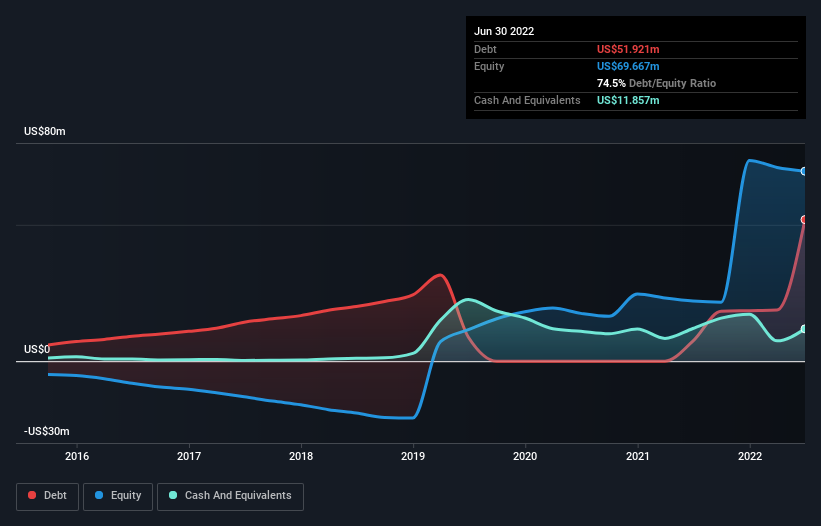Some say volatility, rather than debt, is the best way to think about risk as an investor, but Warren Buffett famously said that 'Volatility is far from synonymous with risk.' When we think about how risky a company is, we always like to look at its use of debt, since debt overload can lead to ruin. We can see that CGX Energy Inc. (CVE:OYL) does use debt in its business. But is this debt a concern to shareholders?
When Is Debt Dangerous?
Generally speaking, debt only becomes a real problem when a company can't easily pay it off, either by raising capital or with its own cash flow. Ultimately, if the company can't fulfill its legal obligations to repay debt, shareholders could walk away with nothing. However, a more usual (but still expensive) situation is where a company must dilute shareholders at a cheap share price simply to get debt under control. Of course, debt can be an important tool in businesses, particularly capital heavy businesses. The first thing to do when considering how much debt a business uses is to look at its cash and debt together.
View our latest analysis for CGX Energy
How Much Debt Does CGX Energy Carry?
The image below, which you can click on for greater detail, shows that at June 2022 CGX Energy had debt of US$51.9m, up from US$7.35m in one year. On the flip side, it has US$11.9m in cash leading to net debt of about US$40.1m.

A Look At CGX Energy's Liabilities
According to the balance sheet data, CGX Energy had liabilities of US$95.8m due within 12 months, but no longer term liabilities. Offsetting this, it had US$11.9m in cash and US$290.6k in receivables that were due within 12 months. So its liabilities outweigh the sum of its cash and (near-term) receivables by US$83.6m.
While this might seem like a lot, it is not so bad since CGX Energy has a market capitalization of US$268.6m, and so it could probably strengthen its balance sheet by raising capital if it needed to. However, it is still worthwhile taking a close look at its ability to pay off debt. There's no doubt that we learn most about debt from the balance sheet. But you can't view debt in total isolation; since CGX Energy will need earnings to service that debt. So when considering debt, it's definitely worth looking at the earnings trend. Click here for an interactive snapshot.
Given its lack of meaningful operating revenue, CGX Energy shareholders no doubt hope it can fund itself until it can sell some combustibles.
Caveat Emptor
Over the last twelve months CGX Energy produced an earnings before interest and tax (EBIT) loss. Indeed, it lost US$12m at the EBIT level. When we look at that and recall the liabilities on its balance sheet, relative to cash, it seems unwise to us for the company to have any debt. So we think its balance sheet is a little strained, though not beyond repair. However, it doesn't help that it burned through US$118m of cash over the last year. So suffice it to say we consider the stock very risky. There's no doubt that we learn most about debt from the balance sheet. However, not all investment risk resides within the balance sheet - far from it. To that end, you should learn about the 4 warning signs we've spotted with CGX Energy (including 3 which can't be ignored) .
Of course, if you're the type of investor who prefers buying stocks without the burden of debt, then don't hesitate to discover our exclusive list of net cash growth stocks, today.
New: AI Stock Screener & Alerts
Our new AI Stock Screener scans the market every day to uncover opportunities.
• Dividend Powerhouses (3%+ Yield)
• Undervalued Small Caps with Insider Buying
• High growth Tech and AI Companies
Or build your own from over 50 metrics.
Have feedback on this article? Concerned about the content? Get in touch with us directly. Alternatively, email editorial-team (at) simplywallst.com.
This article by Simply Wall St is general in nature. We provide commentary based on historical data and analyst forecasts only using an unbiased methodology and our articles are not intended to be financial advice. It does not constitute a recommendation to buy or sell any stock, and does not take account of your objectives, or your financial situation. We aim to bring you long-term focused analysis driven by fundamental data. Note that our analysis may not factor in the latest price-sensitive company announcements or qualitative material. Simply Wall St has no position in any stocks mentioned.
About TSXV:OYL
CGX Energy
Engages in the exploring and evaluating petroleum and natural gas properties in the Guyana Suriname, South America.
Slight risk with mediocre balance sheet.
Market Insights
Community Narratives



